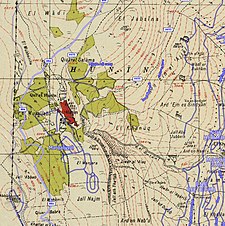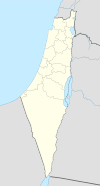Hunin

Hunin
هونين | |
|---|---|
Village | |
| Etymology: from personal name,[1] | |
A series of historical maps of the area around Hunin (click the buttons) | |
Location withinMandatory Palestine | |
| Coordinates:33°13′8″N35°32′43″E/ 33.21889°N 35.54528°E | |
| Palestine grid | 201/291 |
| Geopolitical entity | Mandatory Palestine |
| Subdistrict | Safad |
| Date of depopulation | 3 May 1948 and September 1948[4] |
| Area | |
| • Total | 14,224dunams(14.224 km2or 5.492 sq mi) |
| Population (1945) | |
| • Total | 1,620[2][3] |
| Cause(s) of depopulation | Evacuation orders from Arab/Lebanese authorities |
| Secondary cause | fear of being caught up in the fighting; expulsion byYishuvforces |
| Current Localities | Misgav Am[5]Margaliot[5] |
Hunin(Arabic:هونين) was aPalestinianArabvillage in theGalilee Panhandlepart ofMandatory Palestine,close to theLebaneseborder. It was the second largest village in the district ofSafed,but was depopulated in 1948.[6]The inhabitants of this village were, similar to the inhabitants ofSouthern Lebanon,Shia Muslims.
History
Iron Age I to Late Byzantine period
The first settlement at the site dates back toIron AgeI (1200-1000 BCE), followed by renewed habitation from thePersianperiod (586-332 BCE) until the latter part of theByzantineperiod (5th-6th centuries CE).[7]
Crusader and Mamluk periods

The castle named in Frankish chronicles asChastel Neuf(inmedieval French) orCastellum Novum(inLatin), and known asQal'at Huninin Arabic, and as (Horvat)Mezudat HunininModern Hebrew,was built in two phases by theCrusadersduring the 12th and 13th centuries (1105–7, 1178 and 1240) and refortified byMamluk sultanBaibarsin 1266.[8]The moat is the only well-visible Crusader feature left,[7]with very little of the medieval structures being preserved.[8]
Ottoman period
The castle was rebuilt in the 18th century[8]byZahir al-Umar,the local Arab ruler of the Galilee between the 1730s until 1775. The castle's 18th-century vaulted gatehouse is the most conspicuous structure still standing.[7]This is the time when the Shi'a village of Hunin began developing near the castle.[7]In 1752, a mosque was constructed in Hunin. The dedicatory inscription has been tentatively read as saying that the prayer house was consecrated toJa'far al-Sadiq,the sixthShiaImam.[9][10]
The village was badly damaged in theearthquake of 1837,according toEdward Robinsonwho visited in 1856.[11]In 1875,Victor Guérinvisited Hunin.[12]In 1881, thePEF'sSurvey of Western Palestinedescribed Hunin as "[a] village, built of stone, joining on to ruined Crusading castle [..], and containing about 100 Moslems. The situation is on a low ridge just before the hills drop down to the east to the Huleh Valley; the hills round are uncultivated, covered with low scrub, but in the valleys there is some arable land. Water is obtained from numerous cisterns; a birket [pool, reservoir[13]] and spring to the south-east. "[14][15]
British Mandate period
TheSyria-Lebanon-Palestineboundary was a product of the post-World War IAnglo-French partition ofOttoman Syria.[16][17]British forces had advanced to a position atTel Hazoragainst Turkish troops in 1918 and wished to incorporate all the sources of theRiver Jordanwithin British-controlled Palestine. Following theParis Peace Conference of 1919,and the unratified and later annulledTreaty of Sèvres,stemming from theSan Remo conference,the 1920 boundary extended the British-controlled area to north of theSykes-Picotline, a straight line between the midpoint of theSea of GalileeandNahariya.The international boundary between Palestine and Lebanon was finally agreed upon by Great Britain and France in 1923, in conjunction with theTreaty of Lausanne,after Britain had been given aLeague of Nationsmandate for Palestinein 1922.[18]
In April 1924, Hunin and six other Shiite villages, and an estimated 20 other settlements, were transferred from theFrench Mandate of Lebanonto theBritish Mandate of PalestinebyFrance.[19][20]In the1931 census of Palestine,the population of Hunin was 1,075, all Muslims, in a total of 233 houses.[21]In the1945 statisticsthe population of Hunin (withHulaandUdeisa[dubious–discuss]) was 1620 Muslims,[2]with a total of 14,224 dunams of land.[3]Of this, Arabs used 859 for plantations and irrigated land, 5,987 dunums were allocated to grain farming,[2][22]while 81 dunams were classified as urban land.[2][23]
In 1945,KibbutzMisgav Amwas established on what was the northern part of village land.[5]The people of Hunin maintained good relations with their Jewish neighbors but had strained relations with the Sunni Muslims ofSafed.[24]
-
Hunin 1937
-
Hunin 1937
-
Hunin, 1946
1948 and aftermath
In May 1948, during the1948 Arab–Israeli War,the villagers of Hunin were given six days to evacuate by Arab, possibly Lebanese authorities.[24]Two weeks later, aPalmachraid caused many to flee to Lebanon, leaving 400 residents in the village.[24]
During a meeting in August 1948, themukhtarsof Hunin and other Shi'ite villages met with the Jews of kibbutzKfar Giladi,declaring their willingness to be good citizens of Israel.[6][24]Their proposal was conveyed to the Israeli government, where it received enthusiastic support from the Minorities MinisterBechor-Shalom Sheetrit.[6][20]A report was made by theMinistry of Minority Affairsrecommending that such an agreement be reached with the 4,700 or so Shi'ites in the region to promote friendly relations with southern Lebanon, to take advantage of the Shi'ites' poor relationship with the majority Sunnis, and to enhance the prospect of a future extension of the border.[19]This proposal was not accepted, despite the support of the Minister of Minority Affairs, Sheetrit.[19]
In August, more inhabitants of Hunin were forced to flee by the IDF.[25]Four village women were raped and murdered by Israeli soldiers during the summer.[24]On 3 September 1948, the IDF raided the village blowing up 20 houses, killing a son of the mukhtar and 19 others and expelling the remaining villagers.[20][24]Most of the villagers took refuge in Shiite villages in Lebanon.[20]
In 1951, MoshavMargaliotwas established just south of the village site.[5]
See also
- Hula massacre(31 October - 1 November 1948) perpetrated by the IDF in Hula, a Lebanese Shi'a village 3 km from Hunin
- Shia villages in Palestine
References
- ^Palmer, 1881, p.21
- ^abcdGovernment of Palestine, Department of Statistics, 1945, p.9
- ^abGovernment of Palestine, Department of Statistics.Village Statistics, April, 1945.Quoted in Hadawi, 1970, p.69
- ^Morris, 2004, p.xvi,village #6. Also gives causes of depopulation.
- ^abcdKhalidi, 1992, p. 455
- ^abcGelber, 2006, p. 222
- ^abcdFreundlich, Amir (September 2007)."Hunin Fortress: Preliminary plan for conservation and development".Conservation Department: Heritage Preservation in Israel.Israel Antiquities Authority.Retrieved28 February2021.
- ^abcPringle (1997), p.79
- ^Sharon, 2007, pp.108-112
- ^Sharon, 2013, p.289
- ^Robinson, 1856, pp.370-371
- ^Guérin, 1880, pp.370-372
- ^Wiktionary,Etymology: بركة
- ^Conder and Kitchener, 1881, SWP I, p.87
- ^Conder and Kitchener, 1881, SWP I, pp.123-125
- ^Fromkin, 1989, p.?
- ^MacMillan, 2001, pp. 392–420
- ^Exchange of NotesArchived2008-09-09 at theWayback MachineConstituting an Agreement respecting the boundary line between Syria and Palestine from the Mediterranean to El Hammé. Paris, March 7, 1923.
- ^abcSindawi, Khalid (2008). Are there any Shi'te Muslims in Israel? ",Holy Land Studies,Vol. 7, No. 2, 183–199.
- ^abcdAsher Kaufman (2006). "Between Palestine and Lebanon: Seven Shi'i Villages as a Case Study of Boundaries, Identities, and Conflict".Middle East Journal.60(4): 685–706.doi:10.3751/60.4.13.
- ^Mills, 1932, p.107[dead link]([https://ecf.org.il/media_items/1088Full Document PDF[ p.118, Original p. 107)
- ^Government of Palestine, Department of Statistics.Village Statistics, April, 1945.Quoted in Hadawi, 1970, p.119
- ^Government of Palestine, Department of Statistics.Village Statistics, April, 1945.Quoted in Hadawi, 1970, p.169
- ^abcdefMorris, 2004, pp.249,447–448
- ^Morris, 2004, p.249
Bibliography
- Conder, C.R.;Kitchener, H.H.(1881).The Survey of Western Palestine: Memoirs of the Topography, Orography, Hydrography, and Archaeology.Vol. 1. London:Committee of the Palestine Exploration Fund.
- Fromkin, D.(1989).A Peace to End All Peace.Macmillan.ISBN978-0-8050-8809-0.
- Government of Palestine, Department of Statistics (1945).Village Statistics, April, 1945.
- Gelber, Y.(2006).Palestine 1948: War, Escape And The Emergence Of The Palestinian Refugee Problem(2 ed.). Sussex Academic Press.ISBN1-84519-075-0.
- Guérin, V.(1880).Description Géographique Historique et Archéologique de la Palestine(in French). Vol. 3: Galilee, pt. 2. Paris: L'Imprimerie Nationale.
- Hadawi, S.(1970).Village Statistics of 1945: A Classification of Land and Area ownership in Palestine.Palestine Liberation OrganizationResearch Center.
- Khalidi, W.(1992).All That Remains: The Palestinian Villages Occupied and Depopulated by Israel in 1948.Washington D.C.:Institute for Palestine Studies.ISBN0-88728-224-5.
- MacMillan, M.(2001).Peacemakers: the Paris Conference of 1919 and its attempt to end war.John Murray.ISBN978-0-7195-6237-2.
- Mills, E., ed. (1932).Census of Palestine 1931. Population of Villages, Towns and Administrative Areas.Jerusalem: Government of Palestine.
- Morris, B.(2004).The Birth of the Palestinian Refugee Problem Revisited.Cambridge University Press.ISBN978-0-521-00967-6.
- Palmer, E.H.(1881).The Survey of Western Palestine: Arabic and English Name Lists Collected During the Survey by Lieutenants Conder and Kitchener, R. E. Transliterated and Explained by E.H. Palmer.Committee of the Palestine Exploration Fund.
- Petersen, Andrew (2001).A Gazetteer of Buildings in Muslim Palestine (British Academy Monographs in Archaeology).Vol. I.Oxford University Press.pp.150−151.ISBN978-0-19-727011-0.
- Pringle, D.(1997).Qal'at Hunin (No. 164).Cambridge University Press.p. 79.ISBN9780521460101.Retrieved4 October2021.
{{cite book}}:|work=ignored (help) - Robinson, E.;Smith, E.(1856).Later Biblical Researches in Palestine and adjacent regions: A Journal of Travels in the year 1852.London:John Murray.
- Sharon, M.(1999).Corpus Inscriptionum Arabicarum Palaestinae, B-C.Vol. 2. BRILL.ISBN90-04-11083-6.p.49
- Sharon, M.(2007).Corpus Inscriptionum Arabicarum Palaestinae, Addendum.BRILL.ISBN978-90-04-15780-4.
- Sharon, M.(2013).Corpus Inscriptionum Arabicarum Palaestinae, H-I.Vol. 5. BRILL.ISBN978-90-04-25097-0.
External links
- Welcome to Huninat PalestineRemembered.com
- Hunin,Zochrot
- Hunin,Villages of Palestine
- Survey of Western Palestine, map 2:IAA,Wikimedia commons
- Hunin,from theKhalil Sakakini Cultural Center









